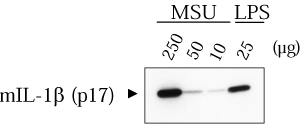NLRP3/NALP3 inflammasome activator. Stimulates the caspase-1 activating NLRP3/NALP3 inflammasome, resulting in the production of active IL-1β and IL-18.
Product Details
| Alternative Name: | MSU (crystals), Uric Acid (crystals) |
| |
| Formula: | C5H3N4O3 . Na |
| |
| MW: | 190.1 |
| |
| CAS: | 1198-77-2 |
| |
| RTECS: | YU7062000 |
| |
| Identity: | Determined by IR. |
| |
| Appearance: | White to off white solid. |
| |
| Solubility: | Soluble in PBS or 1M NaOH (25 mg/ml). Solution may appear as a slightly hazy suspension. |
| |
| Shipping: | Ambient Temperature |
| |
| Long Term Storage: | -20°C |
| |
| Handling: | Vortex before use. |
| |
| Protocol: | Example:
Activation of THP-1 cells by uric acid:
- THP-1 cells are cultured in RPMI 1640 supplemented with 10% heat inactivated fetal bovine serum (FCS), 50μM β-mercaptoethanol, 2mM L-glutamine and penicillin/streptomycin. THP-1 cells are grown in suspension to a density of 0.7-1.5x106 cells/ml in tissue culture flasks.
- Treat THP-1 cells for 3 hours with 25ng/ml PMA (Prod. No. BML-PE160) the day before stimulation.
- Wash cells with PBS and plate them in a 12-well plate at a density of 6x105 cells/well (or 6-well plate at density of 1x106 cells/well) in RPMI medium (this increases the phagocytic properties of the cells and induces a constitutive production of proIL-1β).
- The next day, wash cells with PBS and add 500µl Optimem (Invitrogen) in 12-well plate or 1mL in 6-well plate.
- Stimulate the cells for 6 hours by addition of 50-200µg/ml of the suspension of uric acid (vortex the suspension just before use).
- As a positive control, 50µg/ml of LPS from E. coli, Serotype R515 (Re) (TLRgrade™) (liquid) (Prod. No. ALX-581-007) are incubated for 6 hours. (50µg/ml LPS showed very strong stimulating response, 10µg/ml could be used for future test)
Detection of the mature IL-1β in the supernatant of uric acid-activated THP-1 cells:
- Collect the supernatant of each well, vortex and centrifuge for 5 min. at 13'000 rpm, then save the supernatant.
- Detection of IL-1β in the supernatant of uric acid-activated THP-1 cells by ELISA (Prod. No. ADI-900-130).
|
| |
| Regulatory Status: | RUO - Research Use Only |
| |

Figure: Detection of the mature IL-1 in the supernatant of THP-1 cells by Western blot after treatment with Monosodium urate (crystals) (Prod. No.
ALX-400-047).
Method: THP-1 cells were treated with 10, 50 or 250µg of uric acid and with 50µg of LPS from
E. coli, Serotype R515 (Re) (TLRGRADE®) (liquid) (Prod. No.
ALX-581-007) as mentioned in the protocol. The supernatant was collected, precipitated and a fraction was loaded in a 15% SDS-gel.
Please mouse over
Product Literature References
Statins repress needle-like carbon nanotube- or cholesterol crystal-stimulated IL-1β production by inhibiting the uptake of crystals by macrophages: H. Cui, et al.; Biochem. Pharmacol.
188, 114580 (2021),
Abstract;
Early endosome autoantigen 1 regulates IL-1β release upon caspase-1 activation independently of gasdermin D membrane permeabilization: A. Baroja-Mazo, et al.; Sci. Rep.
9, 5788 (2019),
Abstract;
Full Text
P2Y6 Receptor Signaling Pathway Mediates Inflammatory Responses Induced by Monosodium Urate Crystals: H. Uratsuji, et al.; J. Immunol.
188, 436 (2012),
Abstract;
Inflammasome activation in NADPH oxidase defective mononuclear phagocytes from patients with chronic granulomatous disease: F. Meissner, et al.; Blood
116, 1570 (2010),
Abstract;
Full Text
Monosodium urate crystals in inflammation and immunity: Y. Shi, et al.; Immunol. Rev.
233, 203 (2010),
Abstract;
Uric Acid-Driven Th17 Differentiation Requires Inflammasome-Derived IL-1 and IL-18: C. Conforti-Andreoni, et al.; J. Immunol.
187, 5842 (2010),
Abstract;
Crystals of monosodium urate monohydrate enhance lipopolysaccharide-induced release of interleukin 1 beta by mononuclear cells through a caspase 1-mediated process: E.J. Giamarellos-Bourboulis, et al.; Ann. Rheum. Dis.
68, 273 (2009),
Abstract;
Malarial hemozoin activates the NLRP3 inflammasome through Lyn and Syk kinases: M.T. Shio, et al.; PLoS Pathog.
5, e1000559 (2009),
Abstract;
Gout-associated uric acid crystals activate the NALP3 inflammasome: F. Martinon, et al.; Nature
440, 237 (2006),
Abstract;
Related Products












